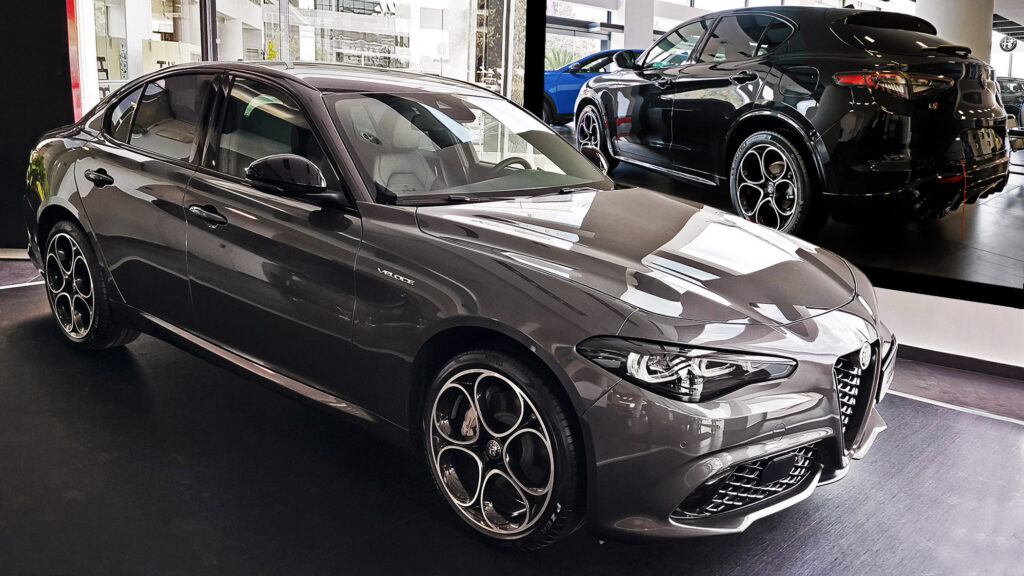Are the changes to the Italian models enough to put them on par with the fierce competition by BMW, Mercedes-Benz, and Audi?
April 9, 2023 at 11:39

by Thanos Pappas
Alfa Romeo might be working on large premium EVs, but until they arrive, the good-old Giulia and Stelvio duo remain the automaker’s ICE-powered flagships, with the romantic flair of being the last of their kind. For 2023, the Italian automaker introduced the second consecutive facelift for the Giorgio-based models, endowing them with more style and more tech, while keeping them non-electrified for their last dance. While North America still gets the older versions, the updated Alfas have already reached dealerships in Europe, which is why paid a visit to a dealership to check them out from up close.
Looks are subjective but Alfa Romeos are generally considered among the most beautiful contestants in the D-segment. Despite the fact that the Giulia was originally introduced in 2015 and the Stelvio followed in 2016, the folk at Centro Stile didn’t need to do much to keep them looking fresh and sexy, since both designs have aged gracefully. In fact, two facelifts later, the majority of the body panels remain identical to the original iterations, with changes focused on the bumpers, wheels, and lighting graphics.
Read: Explore The Refreshed 2023 Alfa Romeo Giulia And Stelvio In New Gallery
Photos Thanos Pappas/CarScoops
The matrix-LED headlights are probably the highlight of the 2023 update, with both the Giulia and the Stelvio taking notes from the smaller Tonale’s rulebook. The triple modules for each cluster and the dark background give a modern look to the Alfa Romeo models. The same applies to the new black pattern on the slightly revised grille and bumper intakes of the Veloce, plus the fresh LED graphics for the taillights.
Last but not least, the Veloce comes standard with gorgeous bi-tone alloy wheels measuring 19 inches in the Giulia and 20 inches in the Stelvio, featuring the classic phone-dial design. Higher-spec Competizione models get even larger alloys which will likely be the case with the upcoming Quadrifoglio performance variants.
Moving inside, Alfa Romeo had already corrected the major flaw of the poor quality lower-trim plastics in the previous update of 2020, bringing them closer to premium rivals. Thus, the only real change for 2023 is the addition of the 12.3-inch digital instrument cluster from the Tonale, with three different styles for the dials – the regular Evolve, the minimalist Relax, and the retro-flavored Heritage. Those are definitely a welcome upgrade over the analog dials, as is the case with the graphics when you press the start/stop button on the steering wheel. However, the digital cockpits of rival models from BMW (3-Series / X3) and Mercedes (C-Class/GLC) have more advanced features.
advertisement scroll to continue
The same applies to the 8.8-inch touchscreen of the infotainment which is carried over from the outgoing models. The graphics are simple, crisp, and well-organized, but the response could be faster. In any case, it is good that you can also operate it from the circular dial on the center console as an alternative to the touchscreen. The flat-bottom steering wheel remains lovely to look at and hold, as with the aluminum shift paddles behind it. The DNA dial gives you easy access to the three driving modes – Dynamic, Natural, and Advanced – with correlating graphics on the infotainment and different setups for the instrument cluster. The Veloce doesn’t have the adaptive dampers found in the Competizione and the Quadrifoglio, which is why there is no dedicated button on the dial.
Overall, you get a premium quality feel, especially in the Veloce with the black leather upholstery and the white stitching for the beautiful seats, while the Competizione takes it a step further by adding a similar treatment for the upper dashboard. Space for the rear passengers is just adequate in the low-slung Giulia, and a lot better in the high-riding Stelvio. Similarly, the boot is 480 lt (16.9 cubic feet) in the sedan and 525 lt (18.5 cubic feet) in the SUV with a larger opening and a more practical shape.
The models we checked out in the Spicar Alfa Romeo dealership in Greece were a gray petrol-powered Giulia Veloce and a black diesel-powered Stelvio Veloce. The powertrain figures remain unchanged compared to their predecessors, with the turbocharged 2.0-liter petrol producing 276 hp (206 kW / 280 PS) and the 2.2-liter turbodiesel making 207 hp (154 kW / 210 PS). In both cases, power is transmitted to all four wheels exclusively through the eight-speed ZF automatic gearbox, with the help of the rear-biased Q4 all-wheel-drive system which is the only option for the Veloce. Note that besides the upcoming Quadrifoglio, the only other engine variant is the entry-level 2.2-liter turbodiesel with 158 hp (118 kW / 160 PS) and rear-wheel-drive.
In terms of pricing, the 2023 MY updates might not be that dramatic, but the automotive and financial landscape has drastically changed, leading to a significant increase compared to their predecessors. More specifically, the Giulia Veloce 2.0 AT 280hp Petrol Q4 costs €65,000 ($71,464), and the Stelvio Veloce 210hp Diesel Q4 costs €69,500 ($76,412). Compared to 2021 prices of the same variants of the pre-facelifted models, those numbers represent an increase of €8,200 ($9,015) and €12,700 ($13,963) respectively.
Until we get a chance to drive the 2023 Alfa Romeo Giulia and Stelvio, check out two short videos we created to highlight the updates. Do you think they will be enough to spark customers’ interest in the Italians against the fierce competition from the likes of BMW, Mercedes-Benz, and Audi? Note that both models will be discontinued in 2026, allowing Alfa Romeo to become an EV-only brand by 2027.
